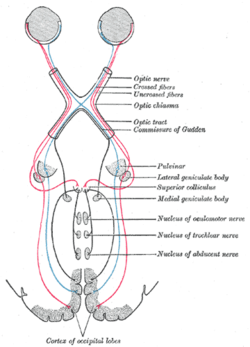Brachium of superior colliculus
| Superior colliculus | |
|---|---|

Section through superior colliculus (unlabeled) showing path of oculomotor nerve
|
|

Scheme showing central connections of the optic nerves and optic tracts. (Superior colliculus visible near center.)
|
|
| Details | |
| Part of | Tectum |
| Identifiers | |
| Latin | Colliculus superior |
| MeSH | A08.186.211.132.659.237.816 |
| NeuroNames | hier-456 |
| NeuroLex ID | Superior colliculus |
| TA | A14.1.06.015 |
| FMA | 62403 |
|
Anatomical terms of neuroanatomy
[]
|
|
The superior colliculus, (Latin, upper hill) is a paired structure of the mammalian midbrain. In other vertebrates the homologous structure is known as the optic tectum or simply tectum. The adjective form tectal is commonly used for mammals as well as other vertebrates.
The superior colliculus/optic tectum forms a major component of the midbrain. It is a layered structure, with a number of layers that varies by species. The layers can be grouped into the superficial layers (stratum opticum and above) and the deeper layers (the remaining layers). Neurons in the superficial layers receive direct input from the retina and respond almost exclusively to visual stimuli. Many neurons in the deeper layers also respond to other modalities, and some respond to stimuli in multiple modalities. The deeper layers also contain a population of motor-related neurons, capable of activating eye movements as well as other responses.
The general function of the tectal system is to direct behavioral responses toward specific points in egocentric ("body-centered") space. Each layer contains a topographic map of the surrounding world in retinotopic coordinates, and activation of neurons at a particular point in the map evokes a response directed toward the corresponding point in space. In primates, the superior colliculus has been studied mainly with respect to its role in directing eye movements. Visual input from the retina, or "command" input from the cerebral cortex, create a "bump" of activity in the tectal map, which, if strong enough, induces a saccadic eye movement. Even in primates, however, the superior colliculus is also involved in generating spatially directed head turns, arm-reaching movements, and shifts in attention that do not involve any overt movements. In other species, the tectum is involved in a wide range of responses, including whole-body turns in walking rats, swimming fishes, or flying birds; tongue-strikes toward prey in frogs; fang-strikes in snakes; etc.
In some vertebrates, including fish and birds, the tectum is one of the largest components of the brain. In mammals, and especially primates, the massive expansion of the cerebral cortex reduces the tectum ("superior colliculus") to a much smaller fraction of the whole brain. It remains nonetheless important in terms of function as the primary integrating center for eye movements.
Note on terminology: This article follows terminology established in the literature, using the term "superior colliculus" when discussing mammals and "optic tectum" when discussing either specific non-mammalian species or vertebrates in general.
...
Wikipedia
